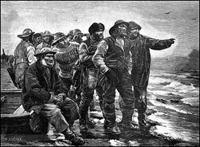Down North on the Labrador Circuit:
The Court of Civil Jurisdiction 1826 to 1833
by Nina Jane Goudie
The Effects of World Events on Newfoundland
Separate and distinct in many ways, the history of Labrador will always be inextricably linked with that of Newfoundland. World events in the late eighteenth and early nineteenth century changed the social, economic and political climate in Newfoundland. In the process, the bounty of resources 'Down North' gave rise to a migratory fishery between the island and the south coast of Labrador which eventually led to permanent settlement there.
Historians agree that cod was Newfoundland's economic lifeline. Newfoundland exported cod to Spain, Portugal, Italy, Europe, Brazil and the British West Indies. Supplying it to international markets enabled her to import necessities which the island could not supply: flour from the United States; rum and molasses from the West Indies; meat and dairy products and manufactured goods from England and Ireland. Thankfully, exports from Newfoundland diversified beyond cod, including seal skins and oil, salmon, fur, herring, mackerel and capelin.19 This of course did not change its needs for staples. Imports ran the gamut from fruit and vegetables to butter, sugar and flour to rum to clothes, rope and lumber. A particularly close commercial relationship developed between the island and states along the eastern seaboard. Thousands of men from New England travelled to Labrador each year to fish and many Newfoundlanders migrated there.20
“Will She Round the Point?”
“Will She Round the Point?” by M. Ancher, ca. 1882.
From Charles de Volpi, Newfoundland: a Pictorial Record (Sherbrooke, Quebec: Longman Canada Limited, ©1972) 170.
 with more information (225 kb). with more information (225 kb).
|

|
The French Revolution and Napoleonic and American wars combined had an important impact on Newfoundland's economy. They temporarily wiped out competition in the international salt fish trade since traditional competitors such as France and the United States were preoccupied with war. Demand for fish sky-rocketed and many around the world looked to Newfoundland. Production of salt fish increased from 661,277 hundredweight in 1804 to 1,086,266 in 1815. From 1805 to 1815 the value of imports and exports each doubled from £231,200 to £590,460, and from £659,280 to £1 183,800 respectively.21 The economy boomed, employment was high and immigrants, most from Ireland, flocked in.
|



